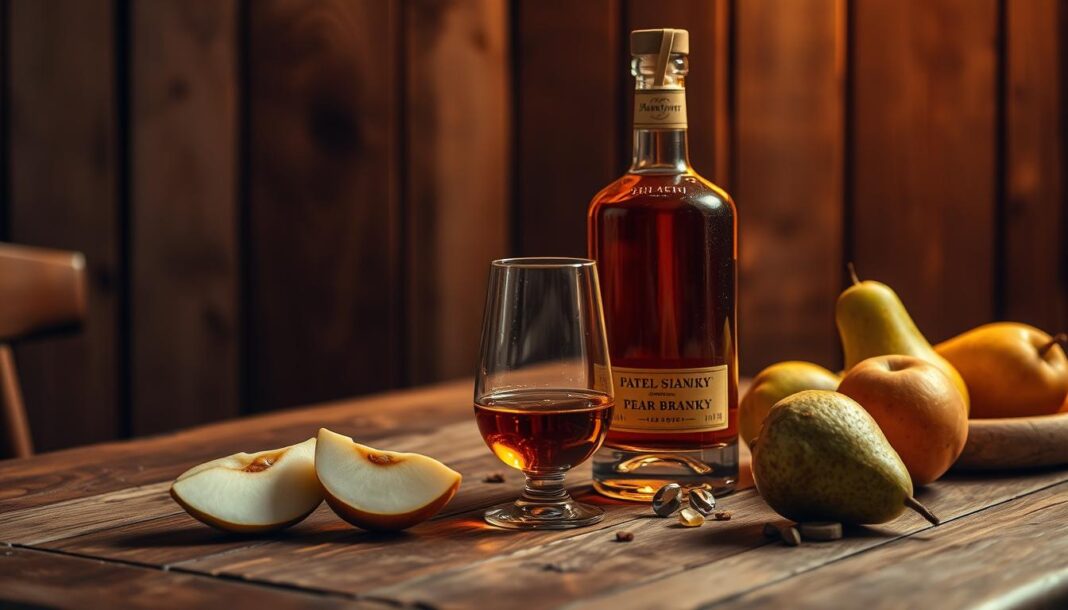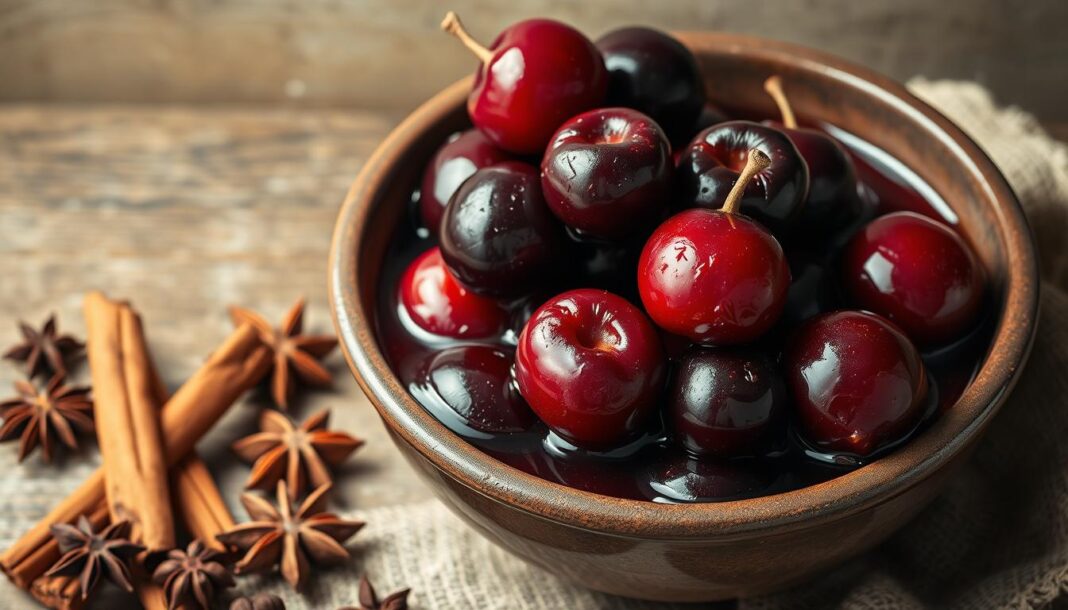Crafting pear brandy at home is a rewarding experience that combines traditional techniques with modern accessibility. This delightful spirit represents a perfect intersection of fruit preservation and spirits crafting, allowing you to capture the essence of ripe pears in a shelf-stable form.
Our expert recipe for homemade pear brandy balances simplicity with authentic flavor development, making this traditional European spirit accessible to both novice and experienced distillers. By understanding the nuances between true pear brandy (eau de vie) and pear-infused spirits, you’ll be better equipped to create a high-quality brandy that meets your expectations.
Key Takeaways
- Crafting pear brandy at home using traditional techniques and modern methods.
- Understanding the difference between true pear brandy and pear-infused spirits.
- Selecting the perfect pears for your brandy recipe.
- Exploring quick infusion methods and traditional approaches.
- Aging techniques to develop complex, balanced flavors in your brandy.
Understanding Pear Brandy: Types and Terminology
Diving into the realm of pear brandy reveals a complex landscape of types, terminology, and production methods. At its core, pear brandy is a liquor distilled from pears, sometimes referred to as eau de vie de poire. This distinction is crucial as it differentiates pear brandy from other pear-flavored spirits.
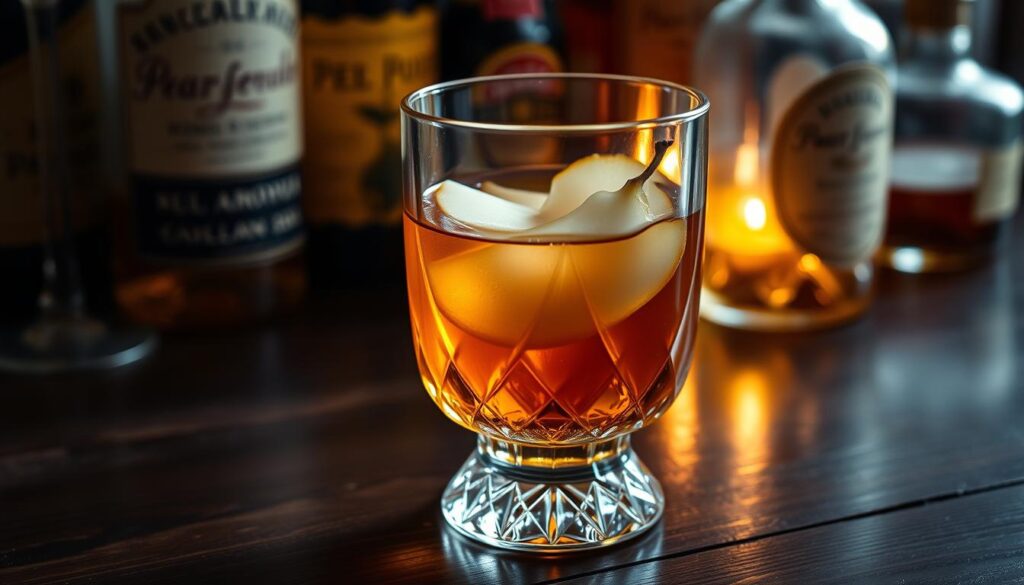
Pear Brandy vs. Pear Liqueur: What’s the Difference?
The primary difference between pear brandy and pear liqueur lies in their production and composition. Pear brandy is distilled directly from fermented pears without any added sugar, whereas pear liqueur is a mixture of a base spirit, sugar, and pear flavoring. The base spirit can be brandy or a liquor made from pears, significantly impacting the final flavor profile.
Commercial Varieties Worth Knowing
Several commercial varieties stand out in the world of pear liqueurs. Rothman & Winter’s Orchard Pear and Mathilde Pear are notable examples that use a pear spirit base, offering bright and fruity flavors. On the other hand, Xante and Brillet pear liqueurs are made with a Cognac base, providing deeper, more complex undertones. These examples serve as valuable references for crafting homemade pear brandy.
Why Make Your Own Pear Brandy
Making your own pear brandy allows for customization and superior flavor compared to commercial products. By using seasonal or homegrown pears, you can create a product that is not only cost-effective but also tailored to your exact preferences in terms of sweetness, intensity, and complementary flavors.
- Customize sweetness and flavor intensity to your liking.
- Achieve superior flavor by using fresh, seasonal fruits.
- Enjoy the cost-effectiveness of making your own pear brandy, especially with homegrown pears.
Essential Ingredients for Homemade Pear Brandy
The foundation of outstanding pear brandy lies in the quality and selection of its core ingredients. We emphasize the importance of choosing the right components to create a truly exceptional homemade pear brandy.
Selecting the Right Base Spirit

The base spirit is a crucial element in making pear brandy. We recommend using a neutral-tasting vodka, as it allows the pear flavor to shine. Vodka is an ideal choice because it is defined as a spirit “without distinctive character, aroma, taste, or color.” While you can experiment with brandy, rum, or whiskey, the results may vary.
Choosing the Perfect Pears
Any variety of pears can be used for making brandy, but we suggest selecting ripe pears with intense flavor. Bartlett and Bosc pears are excellent choices, as they impart distinct characteristics to the final product. The natural sugar content of the pears is also important, especially when using traditional fermentation methods.
Additional Flavoring Ingredients
To enhance the flavor of your pear brandy, consider adding complementary ingredients. Cinnamon adds warmth, ginger contributes a spicy zing, and lemon zest brightens the overall profile. You can also use organic cane sugar to make a simple syrup, which plays a crucial role in extracting and preserving the fruit flavors during infusion. The quality of water used in the syrup is also important, as impurities can affect the flavor and preservation properties of the finished brandy.
Equipment You’ll Need for Success
The journey to creating exceptional pear brandy begins with gathering the essential tools. Making pear brandy is a multi-step process that requires specific equipment to ensure the best flavor and quality.
Basic Tools and Containers
For a successful pear brandy production, you’ll need a few basic tools and containers. We recommend using glass containers as they’re non-reactive and won’t impart unwanted flavors during the extended infusion period. A 1-gallon glass jar is ideal for full batches, while a 1/2 gallon jar is perfect for smaller test batches.
Basic kitchen tools include sharp knives for pear preparation, measuring cups for precise ingredient ratios, a saucepan for creating sugar syrup, and a wooden spoon for stirring without introducing metallic flavors. For filtration, a fine-mesh strainer followed by coffee filters will help achieve clarity and stability in your finished product.
Optional Equipment for Advanced Methods
For those pursuing traditional fermentation methods, additional equipment like fermentation locks, airlocks, and specific gravity meters become important things to consider. While not strictly necessary, optional equipment like a refractometer for measuring sugar content or a pH meter for monitoring acidity can help achieve more consistent results.
For those interested in true distillation (where legally permitted), specialized equipment requirements increase substantially, including proper stills, condensers, and safety gear. Proper storage containers, such as swing-top glass bottles or mason jars with tight-fitting lids, are crucial for maintaining flavor integrity during aging.
How to Make Pear Brandy: Step-by-Step Process
The art of making pear brandy involves several key steps, from preparation to infusion, that we’ll walk you through. This process requires attention to detail, patience, and a bit of creativity. By following our guide, you’ll be able to create a high-quality pear brandy that’s sure to impress.
Preparing Your Pears
To start the process of making pear brandy, you need to properly prepare your pears. We begin by washing them thoroughly, removing seeds and cores while leaving the nutritious and flavorful skins intact. Then, we chop the pears into small pieces to maximize the surface area for flavor extraction. This step is crucial for achieving a rich and complex flavor profile in your final product.
Creating the Sugar Syrup
Creating the perfect syrup requires attention to detail. We recommend combining equal parts sugar and water in a pot, bringing it to a gentle boil for about 5 to 7 mins until the sugar fully dissolves. Then, reduce the heat and simmer for an additional 5 minutes. Let the syrup mixture cool completely before adding it to your infusion. This step helps to balance the flavors and achieve the desired level of sweetness.
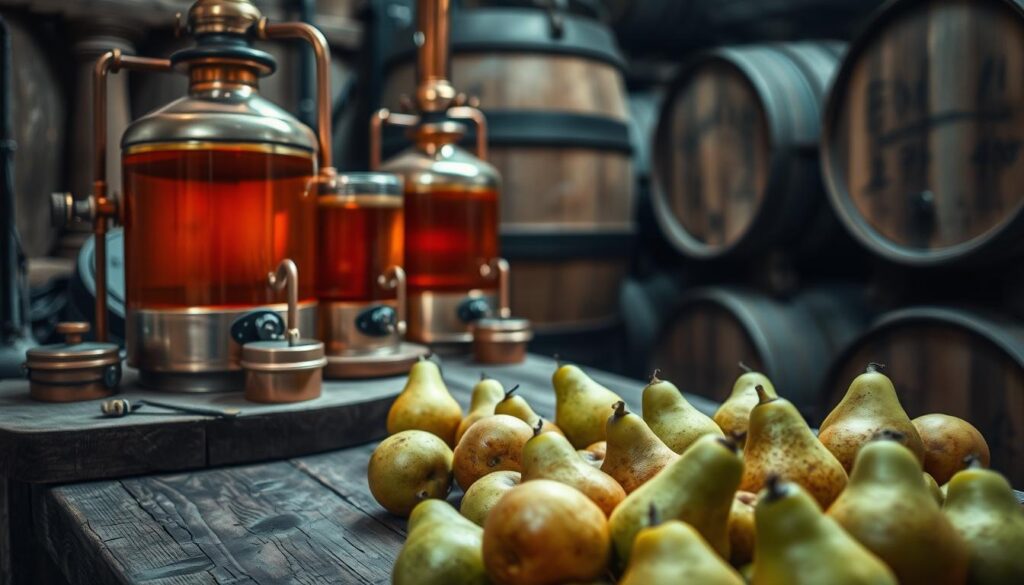
Combining Ingredients
The initial infusion stage involves combining your prepared pears with your chosen base spirit in a clean glass container. Ensure that the fruit is fully submerged to prevent oxidation and potential spoilage. We add a split and scraped vanilla bean to the jar for extra flavor. The jar should have enough room to add another cup of liquid later in the process.
The Infusion Process
Patience becomes crucial during the steeping process, which typically requires a couple of weeks at minimum. During this time, we recommend gently agitating the jar every couple of days to redistribute the ingredients and promote even flavor extraction. This slow and gentle process allows the flavors to meld together beautifully.
Straining and Filtering
Once the infusion is complete, it’s time to strain and filter your pear brandy. We start by removing large solids through a fine-mesh strainer. Then, we achieve final clarity by filtering the liquid through coffee filters, which may need to be changed several times as they become clogged. When you’re satisfied with the flavor, you can add sugar syrup to taste, stirring well to combine.
By following these steps and being mindful of the process, you’ll be able to make pear brandy that’s both delicious and refined. Enjoy the journey and the fruits of your labor!
Alternative Methods and Variations
Pear brandy production is not a one-size-fits-all process; different methods and variations can significantly impact the final product. We will explore several approaches to making pear brandy, from traditional fermentation and distillation to quicker infusion techniques and exciting flavor variations.
Traditional Fermentation and Distillation Method
The traditional method involves fermenting crushed pears into a “must,” which is then distilled to produce true pear brandy. This authentic approach requires specialized equipment but yields the most traditional result. Proper brandy is made without adding sugar; adding sugar creates what’s known as a “sugar head.” Distillation enthusiasts often debate the merits of different distillation techniques, with some preferring the purity of natural sugars.
When fermenting fruits like pears, the natural sugars present determine the potential alcohol content. Testing the juice for its sugar content before adding any sugar is crucial. Our experience with distilling pears shows that the flavor comes over throughout the run but is strongest just as the tails begin.
| Method | Description | Equipment Needed |
|---|---|---|
| Traditional Fermentation and Distillation | Fermenting crushed pears into a “must” and then distilling it. | Specialized distillation equipment |
| Quick Infusion | Accelerated infusion techniques for a faster result. | Cream whippers or sous vide machine |
| Flavor Infusion | Adding flavor variations like vanilla, cinnamon, or ginger. | Basic infusion equipment |
Quick Infusion Techniques
For those seeking a quicker way to enjoy pear-infused spirits, accelerated infusion techniques can produce enjoyable results in as little as a week. Methods include using cream whippers charged with nitrous oxide or the sous vide method, which uses precise temperature control to speed extraction.
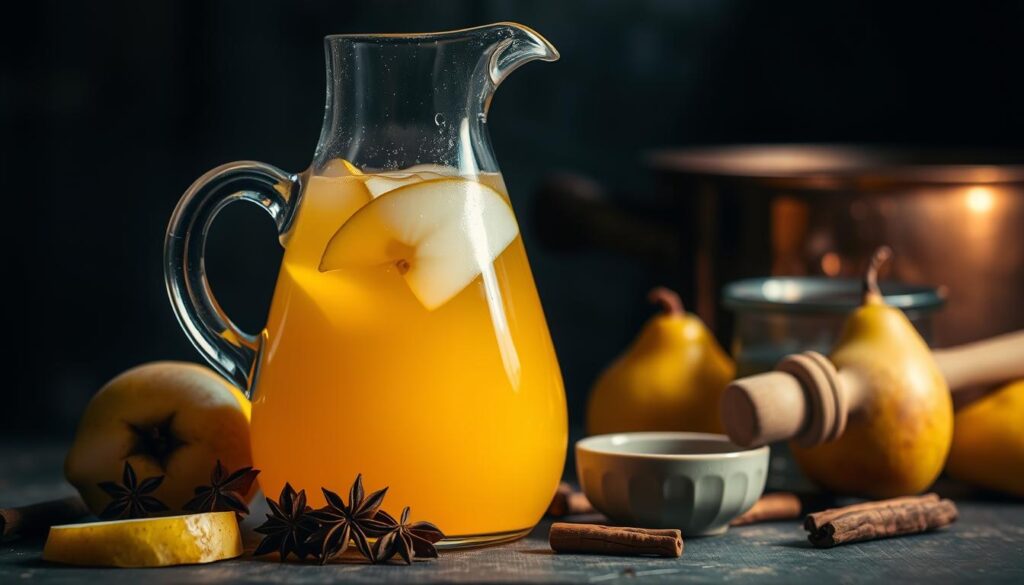
Flavor Variations to Try
Experimenting with different flavor variations can transform your pear brandy into something uniquely personal. Consider adding complementary ingredients like vanilla, cinnamon, or ginger to create a distinct flavor profile. The choice of base spirit also dramatically affects the final product; using vodka provides a neutral canvas, while gin adds botanical notes, and whiskey contributes complexity through oak and grain characteristics.
When trying different pear recipes, remember that the key to a great pear brandy lies in balancing the natural flavors of the fruits with any additional ingredients. Whether you’re using a traditional method or a quicker infusion technique, the art of crafting the perfect pear brandy is a journey worth exploring.
Aging, Bottling, and Storage Tips
To ensure your homemade pear brandy reaches its full potential, understanding the best practices for aging, bottling, and storage is essential. The process of aging significantly enhances the flavor of your homemade pear liqueur, with optimal aging time typically ranging from one month to a full year.
Optimal Aging Time
The aging process for homemade pear brandy involves several distinct phases. Initially, harsh alcohol notes soften, followed by a period where flavor compounds integrate, and finally, a maturation point where the brandy develops its full complexity. We recommend allowing the pears to infuse for at least a month before straining them out, and then waiting another six months before enjoying your brandy.
Proper Bottling Techniques
Once your pear brandy has aged to your liking, it’s crucial to bottle it correctly. Use sterilized glass containers with airtight seals to prevent contamination and oxidation. Leaving minimal headspace in the bottle reduces the risk of spoilage, and considering the addition of a small amount of higher-proof neutral spirit can act as a preservative for extended storage.
Storage Conditions for Maximum Flavor
The ideal storage conditions for your finished brandy include a cool, dark environment with minimal temperature fluctuations. Direct sunlight and heat can damage delicate flavor compounds found in pear-infused spirits. While refrigeration isn’t strictly necessary for spirits with sufficient alcohol content, it can extend the optimal flavor window, particularly for lower-alcohol or sweeter variations. For those experimenting with spices like cinnamon, monitoring the aging time is crucial to avoid overpowering flavors.
Conclusion: Enjoying Your Homemade Pear Brandy
The culmination of your efforts in crafting homemade pear brandy opens up a world of delightful possibilities. As you’ve discovered, this versatile ingredient can elevate various culinary and mixological creations.
Enjoy your pear brandy in small amounts, either on its own or mixed with seltzer, and explore its potential in cocktails. For instance, it pairs beautifully with Champagne, and adding a squeeze of lemon can enhance its flavor profile. You can also drizzle it over vanilla ice cream for a delicious dessert topping.
Feel free to experiment with different pear recipe variations by adjusting sweetness levels or incorporating complementary flavors like cinnamon. The possibilities are endless, and we encourage you to try new combinations today. For those who wanted to try something different, diluting your pear brandy with club soda creates a refreshing spritzer.
Whether you’re looking to impress guests with your mixology skills or simply enjoy a quiet evening with a unique cocktail, your homemade pear liqueur is sure to be a hit. So go ahead, get creative, and find your new favorite way to enjoy the fruits of your labor.
